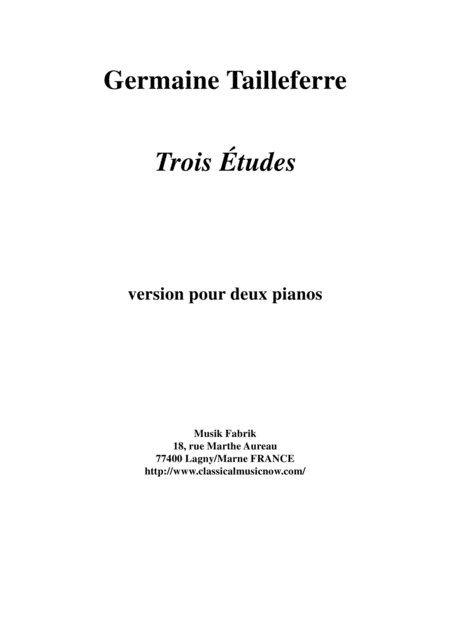Instrumental Duet Instrumental Duet,Piano - Level 5 - Digital Download SKU: A0.534483 Composed by Germaine Tailleferre. 20th Century,Concert,Standards. Score and parts. 65 pages. Musik Fabrik Music Publishing #3534799. Published by Musik Fabrik Music Publishing (A0.534483). This work was written in the first months of 1942 while Tailleferre was living in Grasse, in the socolled« Free Zone » of occupied France during the Second World War and was completed just asTailleferre was forced to flee France with her daughter. As the wife of Jean Lageat, who had been thesecretary of the French socialist Léon Blum during the « Front Populaire » period just before the Warand who was at that time in the US working against the Vichy Government, and as someone who wasnot unvocal about her political views, this could not have been a comfortable situation. Tailleferre left arecord of what she experienced during this period in an article written for the American music journal «Modern Music » which she wrote shortly after arriving in America in the Spring of 1942 :« Notwithstanding their staunch spirit of resistence, the people under German rule today areincreasingly bowed down under their burdens. By achieving the physical decline of the French, theNazis hope that spiritual collapse will ensue. However, after two years of quasi-famine, France remainspround and great, although the necessity of liberation grows daily more urgent.....For an artist to workunder these conditions is almost impossible. The mere effort of subsisting wastes time and absorbsenergy ; The means to work are also lacking.....Musical composition is made practically impossiblethrough lack of music paper. For more than a year, I sought in vain to find paper in Lyon, Marseillesand Nice on which to copy an orchestral score...Two years of experience under German rule havetaught me that all expressions of pride, dignity, spirit , aspiration of the human will can be made onlyclaudestinely. It is a historical truth that the human mind makes its greatest progress under freedom ».Under such circumstances, it is a miracle that this work exists at all. The three movement work wasdedicated to the famous Marguerite Long, for whom Tailleferre had already written several short worksfor piano solo, and François Lang, a pianist who was closely linked with the Group des Six and whohad performed in the première of the 1934 Concerto Grosso for Two Pianos, 8 Solo Voices, SaxophoneQuartet and Orchestra and for whom Tailleferre wrote two cadenzas for concerti by Mozart and Haydn.The work opens with sunny, optimistism in a mood similar to the opening movement of the ConcertoGrosso, but quickly the mood changes to more dramatic themes. The second movement seems tosubjectively express a rupture with the past and a tragic melancholy. The final third movement isextremely dramatic and almost frightening with itâs force.When Tailleferre left France in the Spring of 1942, having been warned by a neighbor that she wasgoing to be arrested if she didnât leave immediately, she left the score in a two-piano version, probablydue to the fact that there was no music paper to be had to copy the score. When she returned to Francein 1946, she learned that François Lang had been deported to Auschwitz where he died. Musical life inFrance had been completely changed by the War years. Tailleferre put the work aside and forgot aboutit, perhaps wanting to forget the hardships that she had lived through and the loss of many of her friendsassociated with these years.Tailleferre's version for two pianos is published by Musik Fabrik and the work may be performed inthat version. It is clear however, that the work was intended to be orchestrated and the editors hope thatthe present orchestration will allow the work to finally be presented as Tailleferre conceived duringsome of the darkest years of the Twentieth century.
